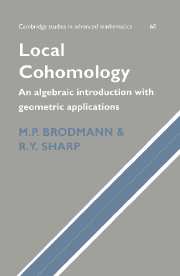Book contents
- Frontmatter
- Contents
- Dedication
- Preface
- Notation and conventions
- 1 The local cohomology functors
- 2 Torsion modules and ideal transforms
- 3 The Mayer-Vietoris Sequence
- 4 Change of rings
- 5 Other approaches
- 6 Fundamental vanishing theorems
- 7 Artinian local cohomology modules
- 8 The Lichtenbaum-Hartshorne Theorem
- 9 The Annihilator and Finiteness Theorems
- 10 Matlis duality
- 11 Local duality
- 12 Foundations in the graded case
- 13 Graded versions of basic theorems
- 14 Links with projective varieties
- 15 Castelnuovo regularity
- 16 Bounds of diagonal type
- 17 Hilbert polynomials
- 18 Applications to reductions of ideals
- 19 Connectivity in algebraic varieties
- 20 Links with sheaf cohomology
- Bibliography
- Index
15 - Castelnuovo regularity
Published online by Cambridge University Press: 04 May 2010
- Frontmatter
- Contents
- Dedication
- Preface
- Notation and conventions
- 1 The local cohomology functors
- 2 Torsion modules and ideal transforms
- 3 The Mayer-Vietoris Sequence
- 4 Change of rings
- 5 Other approaches
- 6 Fundamental vanishing theorems
- 7 Artinian local cohomology modules
- 8 The Lichtenbaum-Hartshorne Theorem
- 9 The Annihilator and Finiteness Theorems
- 10 Matlis duality
- 11 Local duality
- 12 Foundations in the graded case
- 13 Graded versions of basic theorems
- 14 Links with projective varieties
- 15 Castelnuovo regularity
- 16 Bounds of diagonal type
- 17 Hilbert polynomials
- 18 Applications to reductions of ideals
- 19 Connectivity in algebraic varieties
- 20 Links with sheaf cohomology
- Bibliography
- Index
Summary
In Chapter 14, we have seen that, when (K is an algebraically closed field, r ∈ ℕ and) R is the homogeneous coordinate ring of a projective variety V ⊆ ℙ(K) of positive dimension, the end of the (necessarily graded) first local cohomology module is of interest: see 14.2.4. This is one motivation for our work in this chapter, where we shall study, in the case when is positively graded, the ends of the local cohomology modules for a finitely generated graded R-module M. Perhaps the most important invariant related to these ends is the so-called (Castelnuovo-Mumford) regularity of M. This invariant is of great significance in algebraic geometry, and, as we shall see in 15.3.7 and 15.3.8, it provides links between local cohomology theory and the syzygies of finitely generated graded modules over a polynomial ring over a field.
Finitely generated components
Our first goal in this chapter is to establish the basic fact that, in the notation of the above introduction, for each i ∈ ℕ0, the R0-module is finitely generated for all n ∈ ℤ and zero for all sufficiently large n. This fact, which generalizes 14.1.4(iii), (ii), is the basis for much of the work in this and the next two chapters. We begin by introducing further convenient notation and terminology.
Notation and Terminology. We shall employ the notation and terminology concerning graded rings and modules described in 12.1.1, 13.1.1 and 14.1.1.
Recall [6, p. 28] that, when is positively graded, we say that R is homogeneous if and only if R is generated as an R0-algebra by its forms of degree 1, that is, if and only if R = R0[R1].
- Type
- Chapter
- Information
- Local CohomologyAn Algebraic Introduction with Geometric Applications, pp. 277 - 293Publisher: Cambridge University PressPrint publication year: 1998



